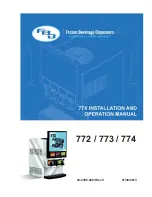
Water Softener
WINNI-mat
®
VGX
Order no. 215 188 040-inter Edited by: KONS-pha-rg G:\BA-188040-INTER-VGX.DOC
11
3 | Ion exchange
Resin
Fig. B-1: Initial position
The exchange of calcium and magnesium ions for sodium ions caus-
es the water to become soft.
Principle
The hard raw water flows through an exchanger. This tank is filled with a
resin, to which sodium ions are bonded (see fig. B-1).
Since these bonding positions at the resin prefer calcium and magnesi-
um ions, these ions are retained while the resin discharges sodium ions
into the water (exchange reaction). In this way, all substances causing
hardness remain in the exchanger. Soft water with sodium ions leaves
the exchanger (fig. B-2). This process continues until a major part of the
sodium ions is exhausted.
Hard water
Soft water
Resin
Fig. B-2: Operation
The exchange reaction can be reversed if a large amount of sodium
ions (salt solution = brine) is added (fig. B-3). By their sheer number,
the sodium ions displace the calcium and magnesium ions at the
docking positions of the resin.
This process restores the initial state. The resin is regenerated and is
again ready for softening.
Drinking water (raw water)
As protection against corrosion, we recommend a soft water hardness
of at least 3 °dH (5.3 °f, 0.53 mmol/l). According to the German Drink-
ing Water Ordinance, the limit value for sodium ions (200 mg/l) should
not be exceeded. This hardness is achieved by adding untreated
drinking water (raw water), a process which is known as blending.
Resin
Waste water
Brine solution
Fig. B-3: Regeneration
Note
: Many popular mineral waters contain significantly more
sodium ions. Check for yourself by reading the analysis results
on the labels.
Sodium ions
Calcium ions
Magnesium
ions












































